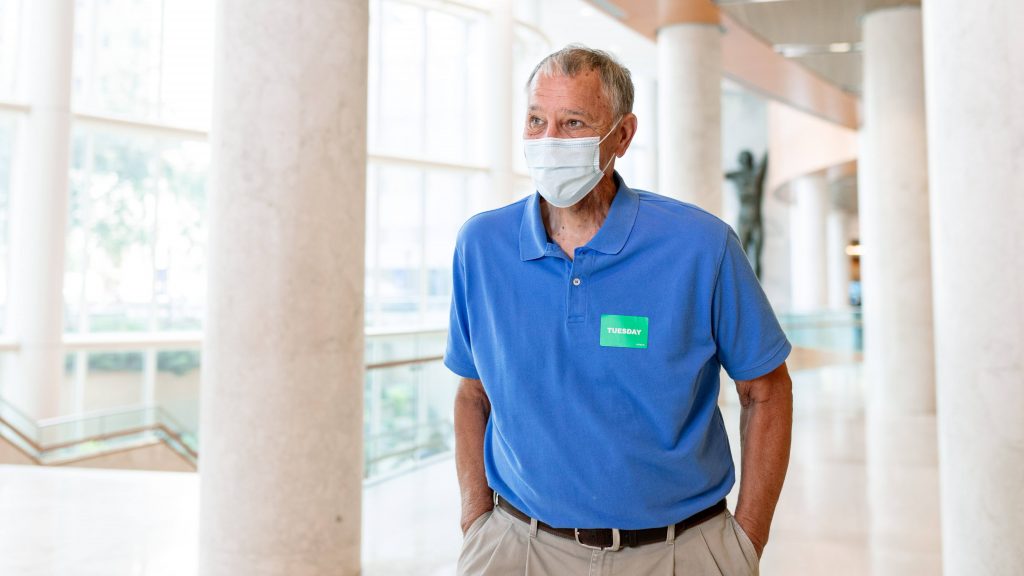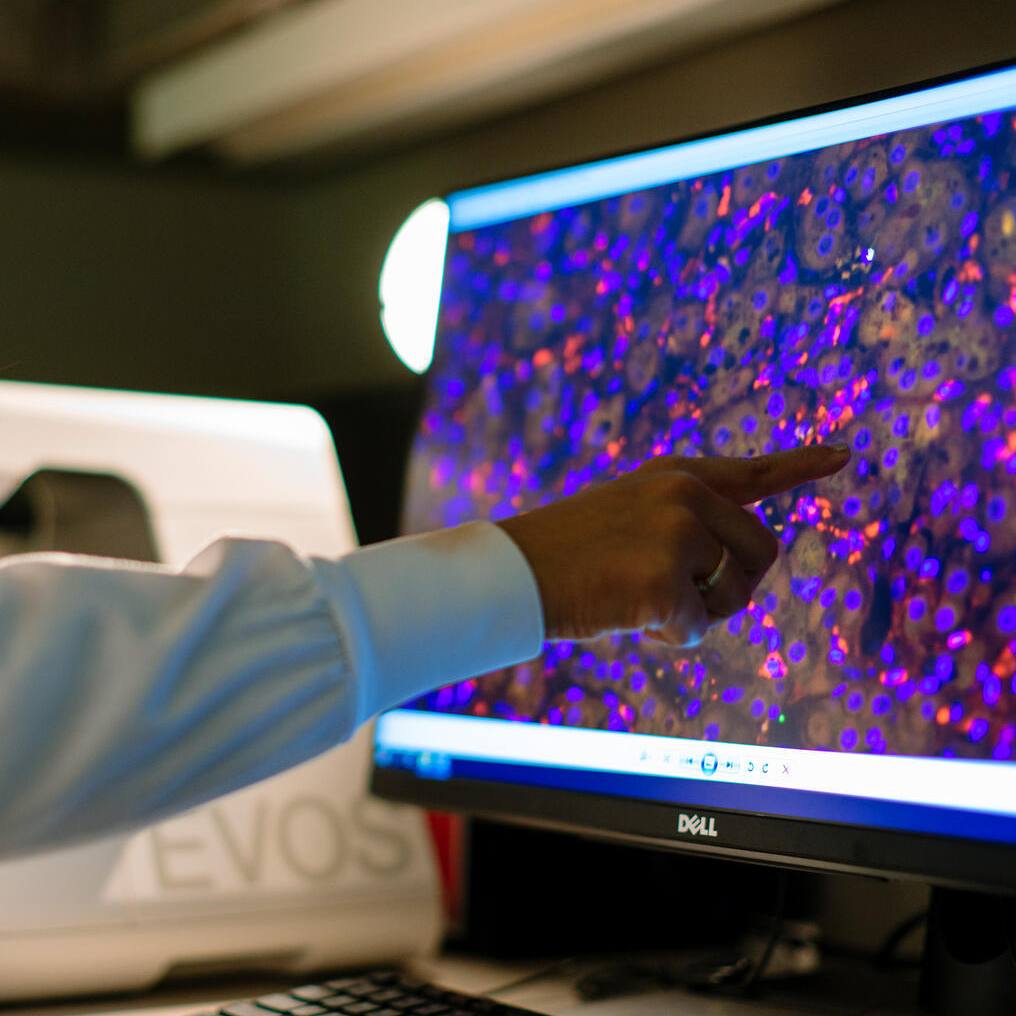-
Patient travels to Mayo during COVID-19 pandemic

The COVID-19 pandemic has impacted us all. Decisions that last year would have been easy to make, leave us questioning if there is a better option. Questions like “should I go to the doctor?” and “how far am I willing to travel?” For one Michigan man, those questions were easy, and the answers led him to Mayo Clinic.
Watch: Patient travels to Mayo to find answers during pandemic
Journalists: Broadcast-quality video (1:47) is in the downloads at the end of this post. Please "Courtesy: Mayo Clinic News Network." Read the script.
Whether James (Jim) Koski is taking a sip of water or a small bite of a scrambled egg he prepares himself for the inevitable choking and coughing that follows.
“Eating is supposed to be fun and enjoyable — but for me, it’s a drag,” says Koski.
What Koski doesn’t mention is that it’s been a drag for over 30 years. In 1988, at age 46, he was diagnosed with squamous cell carcinoma in his neck. After a bilateral neck dissection and radiation therapy his cancer was gone — but in its place came a chronic sore throat, dry mouth and difficulty swallowing.
“I’ve been living with this condition for years and finally, at age 77, I got fed up and was ready to try something,” says Koski. “However, I first had to deal with my fear of traveling during the COVID-19 pandemic.”
Koski called Mayo Clinic in January, before the COVID-19 pandemic was a household word, and was scheduled for a March appointment. But by early March COVID-19 was in full force in the United States. Mayo Clinic rescheduled his appointment to early June.
“I was hesitant to come in June with everything going on,” says Koski. “My wife, MJ, was terrified about me getting COVID-19 due to the travel.”
After three months of self-quarantine neither of them wanted to take the risk of traveling to Mayo. But after much discussion they decided the best option would be for him to travel the 670 miles from Saginaw, Michigan, to Rochester, Minnesota, alone. Originally he was going to drive but decided to fly to save time and for the convenience.
Koski says his biggest concern was other people. Would they practice social distancing? Wear a mask?
“I found it to be no more dangerous than going to the grocery store,” says Koski. “I felt very safe and saw all of the precautions that were being taken on the plane, in the airport and at Mayo Clinic.
As Koski can attest to Mayo Clinic welcomes new and returning patients with safe in-person and virtual care. Patients will experience precautions such as universal masking, temperature checks, screening questions, social distancing and more.
Before Koski met with his physicians he was tested for COVID-19 to determine if he'd had the virus (blood test) or currently had it (nasal swab test). Both tests were negative and he was relieved that he could continue with his appointments.
Koski met with Andy Liu, M.D., a fellow in Gastrointestinal Motility, and Cadman Leggett, M.D., a consultant in the Division of Gastroenterology and Hepatology.
“They took a lot of notes and listened to me,” says Koski. “I could tell they had taken the time to read my history. I’ve been to enough doctors to know the difference between the ones who glance at your file before they walk in and the ones who study it the night before.”
The next day he underwent an upper endoscopy, a nonsurgical procedure used to examine a person’s digestive tract. An attempt was made to pass a small flexible tube (endoscope) through his mouth and into his esophagus (the food pipe leading from the mouth into the stomach).
However, his esophagus was too soft and fragile from his past radiation treatments, and he began to bleed. The procedure was stopped to protect his breathing. On the second attempt he was intubated to assist with his breathing during the procedure. This time his esophagus was too narrow and difficult to find — even using a child’s endoscope, so this attempt also failed.
After consulting with a team of specialists, Koski was scheduled the next week for a percutaneous endoscopic gastrostomy (PEG) procedure. Dr. Wong Kee Song, an advanced endoscopist, performed his procedure. Using x-ray guidance and novel techniques an endoscope was succesfully advanced through the esophagus and into the stomach. The endoscope is used to ensure the correct positioning of the PEG tube (also called a feeding tube)
The procedure allowed the physicians to access his esophagus and attempt to stretch it to make swallowing easier. A normal esophagus is less than an inch in diameter when relaxed. Koski’s esophagus was 4 millimeters — smaller than the size of a pen. The esophageal dilation resulted in stretching his esophagus to 12 millimeters.
After the procedure Koski took his first sip of water and didn’t choke — a sign that the procedure was working. But he knows it may take several repetitions of the procedure to get his esophagus to a point where he can continue to swallow without choking.
“I have to travel to Mayo in about six weeks to get my throat stretched again, and this may be an ongoing procedure,” says Koski.
“I’m not worried any more about traveling for care after seeing the precautions and safety measures in place at Mayo,” says Koski. Life has to go on and if it’s all for naught, at least I know I tried and gave it my best shot.”
In addition to Mayo’s COVID-19 readiness the city of Rochester has prioritized the health and safety of residents and visitors. ROCHESTER READY is an initiative to ensure a safe and resilient recovery to ensure measures are in place to lessen the risk of COVID-19 transmission. Effective July 8, an emergency declaration amendment requires masks in indoor public spaces in Rochester.
Information in this post was accurate at the time of its posting. Due to the fluid nature of the COVID-19 pandemic, scientific understanding, along with guidelines and recommendations, may have changed since the original publication date.
For more information and all your COVID-19 coverage, go to the Mayo Clinic News Network and mayoclinic.org.







